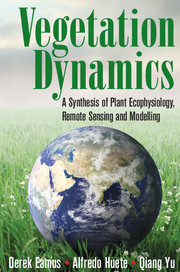Book contents
- Frontmatter
- Contents
- Preface
- Section One Plant Ecophysiology
- Section Two Remote Sensing
- Section Three Modelling
- Section Four Case Studies
- 14 Boreal Forests
- 15 Arid and Semi-Arid Grasslands
- 16 Savannas
- 17 Seasonal Behaviour of Vegetation of the Amazon Basin
- 18 Tropical Montane Cloud and Rainforests
- 19 Groundwater Dependent Ecosystems
- 20 Global-Change Drought and Forest Mortality
- Index
- References
19 - Groundwater Dependent Ecosystems
from Section Four - Case Studies
Published online by Cambridge University Press: 05 June 2016
- Frontmatter
- Contents
- Preface
- Section One Plant Ecophysiology
- Section Two Remote Sensing
- Section Three Modelling
- Section Four Case Studies
- 14 Boreal Forests
- 15 Arid and Semi-Arid Grasslands
- 16 Savannas
- 17 Seasonal Behaviour of Vegetation of the Amazon Basin
- 18 Tropical Montane Cloud and Rainforests
- 19 Groundwater Dependent Ecosystems
- 20 Global-Change Drought and Forest Mortality
- Index
- References
Summary
Introduction
Much of the global land surface is arid or semi-arid, where water supplies limit plant growth, food supplies, and human population densities. Groundwater is a major resource to both humans and the ecology in such regions, and groundwater extraction is increasing exponentially in many regions. In the past three decades research has increasingly shown that in many places, terrestrial vegetation can also be reliant on the availability of groundwater. In order to allocate water to sustain these groundwater dependent ecosystems, which have commercial, ecological, and amenity value, knowledge of their location, their water requirements, their structure, and an understanding of how they respond to changes in water supply are required. Ecophysiological and remote sensing studies are now being combined to increase our understanding of these issues.
Field assessments of vegetation water-use using eddy covariance, sapflow sensors, and stable isotopes are combined with remotely sensed data and models to determine rates of vegetation water-use, rates of groundwater-use, and the location of groundwater dependent ecosystems across landscapes.
The location of groundwater dependent ecosystems (GDEs) can be difficult to identify, especially as they are often located in arid and semi-arid regions with low population densities and sparse infrastructure. Quantifying their rate of water-use has been equally problematic in the past but the application of remotely sensed data has provided a spatially extensive method to overcome these problems.
The three big questions addressed in this case study are: (1) how can we find GDEs in a landscape; (2) what is the rate of water-use for GDEs; and, (3) can remote sensing and ecophysiology be combined to study GDEs?
Groundwater and Groundwater Dependent Ecosystems
The water table represents the surface (interface) between the water-saturated, oxygen-depleted aquifer below and the aerated soil above. Roots are mostly confined to the aerated soil and the capillary fringe above the aquifer. The capillary fringe is the depth of soil that receives water moving vertically from the aquifer through capillary rise. In course-textured soils (sand) the capillary fringe is narrow (measured in centimetres) while in fine-textured soils (silt) it may be up to 2 m in depth.
Groundwater (water stored underground in an aquifer) is the largest store of liquid (i.e. not frozen) freshwater in the world, accounting for about 96 percent of global liquid freshwater (Shiklomanov 2008).
- Type
- Chapter
- Information
- Vegetation DynamicsA Synthesis of Plant Ecophysiology, Remote Sensing and Modelling, pp. 460 - 483Publisher: Cambridge University PressPrint publication year: 2016
References
- 1
- Cited by



